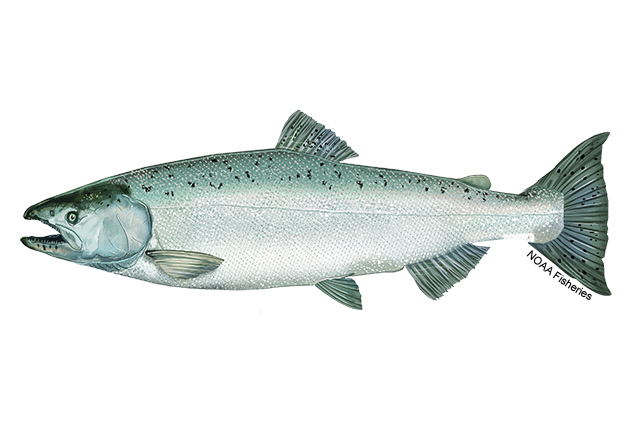
Oncorhynchus tshawytscha
Fishes
Chinook Salmon, King Salmon, Quinnat, Quinnat Salmon, Saumon Chinook, Spring Salmon, Tyee
Oncorhynchus tshawytscha (Chinook Salmon) is native to: Arctic and Pacific drainages; spawning from Cape Hope Alaska to San Francisco Bay, California and in Asia, in Pacific Russia, and Honshu, Japan. Adults range throughout cooler waters of the North Pacific. This salmon was widely introduced n North America, outside its native range, largely unsuccessfully, by the United States Fish Commission and state agencies. In 1873-1880, it was shipped to 26 states, including such unlikely places as Alabama, Texas, and Utah. and the 'Sandwich Islands' (Hawaii). In past years, experiments have been made on a rather extensive scale to acclimatize the Chinook Salmon on the Atlantic coast. No results appeared to have followed these efforts' (Bowers 1906). Thousands to millions of hatchery reared salmon were released in East Coast bays, with little to no survival or spawning. There were additional introduction attempts in the 20th century, but no reported success Establishment of O. tshawytscha in the Great Lakes did not occur until the 1960s. These populations have some natural reproduction, but the sport fishery is dependent on stocking. In the late 19th century, introductions were also made in Mexico, Nicaragua, Argentina, Chile, Europe, Australia, and New Zealand. The initial (1876) New Zealand stocking was unsuccessful, but releases in 1901-1905 resulted in spawning populations on the South Island. Extensive salmonid aquaculture began in Chile in the 1980s, and spawning populations were reported by 1989. Occurrences in Atlantic Argentina have resulted from aquaculture operations in the Gulf of Magellan.